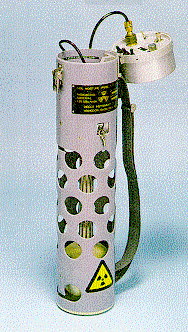
Changes in moisture content of a soil, over time and down a profile, can be determined using a neutron probe system (Bell 1976). The system requires permanently installed 40mm internal diameter aluminium alloy access tubes. The tubes are sealed at their lower end with an aluminium nose cone, and at the other end with a removable neoprene bung. Soil moisture measurements are taken from each tube in turn using a portable neutron probe.
Figure 11: The neutron probe

The probe consists of a radioactive source combined with a Boron trifluoride detector. The probe is connected to an access tube, and the source then lowered to the depth from which measurements are to be taken. The source emits fast neutrons into the surrounding soil which, on collision with hydrogen atoms, are scattered and slowed down to thermal velocities. The 'cloud' of slow neutrons can then be sensed by the detector, allowing a mean count rate (in counts per second) to be recorded electronically by the probe's ratescaler over either a 16 or 64 second period. A graduated depth counter on the probe enables measurements to be taken accurately at 100mm intervals down the length of the access tube, except for approximately the final 100mm which is inaccessible to the source.
The count rate from each recording depth is linearly related to the volumetric moisture content of the soil by use of a calibration curve. The wetter the soil, the greater chance of collisions near the probe's detector between neutrons and the nuclei of hydrogen in the soil, which is mainly in the form of water. However, every element present in the soil matrix has scattering and absorbing properties for neutrons which, although individually much less than that of hydrogen, together influence the count rate to an extent. Every soil therefore has, in theory at least, a unique calibration curve.
The access tubes are installed into a borehole created by hand using a system of steel guide tubes. The 1m sections of guide tubes are driven into the ground using a weighted rammer. As soil material passes into the guide tube it is removed with a screw auger and immediately described to produce a profile log. Once the desired depth has been reached, the guide tubes are jacked out and the access tube then carefully inserted into the borehole to the full depth. The borehole created should be 100mm deeper than the selected length of access tube to allow for the tube's nose cone.
For accuracy of monitoring it is important that a tight fit is achieved between the 'soil' and access tube. This is to avoid air gaps or water draining down the side of the tube.
© Author(s). Content published prior to 2013 is not covered by CC-BY licence and requests for reproduction should usually go to the copyright holder (in most cases, the author(s)). For citation / fair-dealing purposes, please attribute the author(s), the title of the work, the Internet Archaeology journal and the relevant URL/DOI.
Last updated: Thur Feb 28 2002